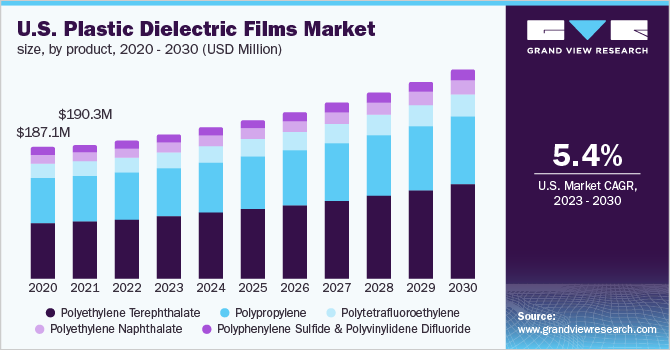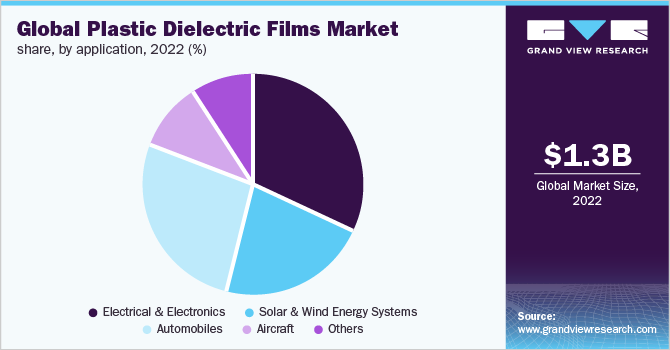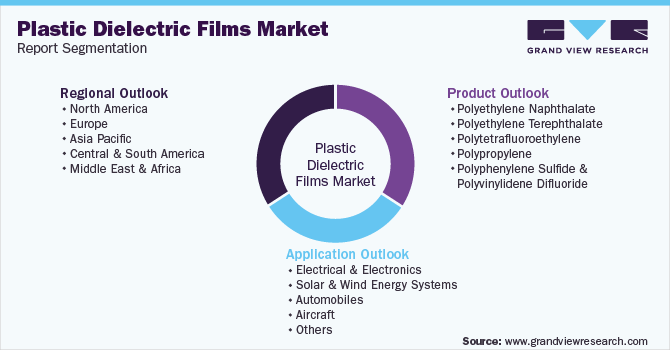- Home
- »
- Plastics, Polymers & Resins
- »
-
Plastic Dielectric Films Market Size & Share Report, 2030GVR Report cover
![Plastic Dielectric Films Market Size, Share & Trends Report]()
Plastic Dielectric Films Market Size, Share & Trends Analysis Report By Product (PEN, PET), By Application (Automobiles, Aircraft, Electrical & Electronics), By Region (APAC, North America), And Segment Forecasts, 2023 - 2030
- Report ID: GVR-2-68038-823-7
- Number of Report Pages: 80
- Format: PDF, Horizon Databook
- Historical Range: 2019 - 2021
- Forecast Period: 2023 - 2030
- Industry: Bulk Chemicals
Report Overview
The global plastic dielectric films market size was estimated at USD 1.28 billion in 2022 and is expected to exhibit a compound annual growth rate (CAGR) of 4.5% over the forecast period. The increasing demand for electronic goods and the growing food packaging industry are driving the industry. The demand for plastic films is high globally in sectors, such as electrical and electronics, food packaging, automobile, aircraft, and solar & wind energy systems.The COVID-19 pandemic had a positive impact on the growth of this market despite the restrictions related to manufacturing during the lockdown. This is attributed to the increased applications of plastic films in pharmaceutical, packaging, and other industries. There were fluctuations in the market in 2021 due to the Russia-Ukraine war. However, the industry is expected to witness significant growth over the forecast period. The global market is expected to witness strong growth during the forecast period due to increasing global demand for solar and wind energy systems applications, and the food packaging industry.

However, the fluctuation in petroleum prices, which is an essential raw material for plastic films, and the lack of self-healing ability of the polymers that make them flammable under over-loaded conditions affects the market demand and supply. Due to its huge economic impact, polymer production is one of the most prominent areas of applied chemistry. Materials made of polymers are used in practically all fields of human activities. Nearly all industries, from the packaging of food and beverages to the transportation sector to the medical sector, now depend heavily on polymers.
Product Insights
On the basis of products, the globalindustry has been segmented into Polyethylene Naphthalate (PEN), Polyethylene Terephthalate (PET), polytetrafluoroethylene, polypropylene, and polyphenylene sulfide & polyvinylidene difluoride. The PET segment accounted for the largest share of 45.75% in 2022, in terms of revenue, and is expected to retain its dominance during the forecast period. The applications driving the segment growth range from packaging to fabrics and films to molded parts for electronics and automobiles, and many more.
On the other hand, the PEN product segment is expected to register the fastest growth rate during the forecast period. This rapid growth can be attributed to the wide application scope of polyethylene naphthalate in film-based products, such as labels, laminates, flexible printed circuits, and optical displays. PEN is a high-performing fiber with enhanced hydrolytic stability and is particularly well-suited for items that are prone to oxidation because of its low oxygen permeability.
Application Insights
The electrical and electronics segment accounted for the largest share of more than 31.20% in 2022 and is expected to retain its position in the market over the forecast period. This is attributed to its wide application scope in engineering materials, such as circuit boards, wire, cable insulation, and others, due to its electrical insulation and flame resistance properties. Desai Electronics Pvt. Ltd., a manufacturer of plastic film capacitors, produces metalized and plain polypropylene and polyester film capacitors that are utilized in the electronics industry for DC links, induction cookers, fan speed regulators, power electronics, energy meters, and more.

The solar and wind energy systems segment is expected to grow at the fastest CAGR over the forecast period. This growth is due to the increase in solar manufacturers’ demand to replace glass with polymers. Organic photovoltaic cells made of polymers are driving new opportunities for solar energy, particularly in the field of transportation. In wind energy systems, the wind turbine’s efficiency can be increased by adjusting the blade’s length. The capacity to produce power increases with blade size. To lighten the turbine and increase its strength and efficiency, polymer composites reinforced with glass, carbon, and aramid fibers are utilized.
Regional Insights
Asia Pacific accounted for the largest revenue share of more than 36.30% in 2022 and is expected to maintain its dominance over the forecast period. Chinaaccounted for the highest share of the regional market in 2022. The market growth is attributed to the growing use of polypropylene in binders, packaging materials, boxes, and others. India is expected to grow at a steady CAGR over the forecast period owing to the rise in government spending on PPE kits and other medical products using polymers.

North America also accounted for a significant revenue share in 2022 and is anticipated to grow at a lucrative CAGR over the forecast period. The U.S. market is expected to grow at the fastest CAGR during the forecast period. The increased use of packaging in the food and beverage industry is one of the key factors propelling the growth of the U.S. PET market. MNCs, such as PepsiCo, Tyson Foods, Nestle, and JBS USA, dominate the food industry in the country resulting in a rise for the need for food and beverage packaging materials across the nation.
Key Companies & Market Share Insights
The industry features various global and regional players, which makes it a competitive market. The world’s leading companies are undertaking strategies, such as collaborations, partnerships, mergers, acquisitions, and agreements, to withstand the intense competition and increase their industry share. Plastic film manufacturers are spending extensively on research & development activities to develop advanced products to conserve energy.
For instance, in the U.S., major beverage manufacturers have pledged to lessen their impact on the environment by moving toward a sustainable future. The PET bottle has several attributes that make it a sustainable material. It has strong barrier qualities as its single-layer, single-material composition makes recycling it simpler.Some of the prominent players operating in the global plastic dielectric films market include:
-
Dupont Teijin Films U.S. Ltd. Partnership
-
Steiner GmbH & CO. KG
-
Jindal Films
-
Tervakoski Film
-
Ganapathy Industries
-
COVEME s.p.a.
-
Jindal Poly Films Ltd.
-
Bolloré Group
-
SABIC
-
Mitsubishi Chemical Corp.
-
Toray Industries, Inc.
-
PPI Adhesive Products
-
SK geo-centric Co., Ltd.
-
Asahi Kasei Corp.
-
Maruzen Petrochemical Co. Ltd.
Plastic Dielectric Films Market Report Scope
Report Attribute
Details
Market size value in 2023
USD 1.3 billion
Revenue forecast in 2030
USD 1.82 billion
Growth rate
CAGR of 4.5% from 2023 to 2030
Base year for estimation
2022
Historical data
2019 - 2021
Forecast period
2023 - 2030
Quantitative units
Revenue in USD million/billion, volume kilo tons, and CAGR from 2023 to 2030
Report coverage
Revenue forecast, volume forecast, company ranking, competitive landscape, growth factors, and trends
Segments covered
Product, application, region
Regional scope
North America; Europe; Asia Pacific; Central & South America; Middle East & Africa
Country scope
U.S.; Canada; Mexico; Germany; France; U.K.; Italy; Spain; Poland; China; India; Japan; South Korea; Australia; Thailand; Malaysia; Brazil; Argentina; Chile; Saudi Arabia; UAE; South Africa
Key companies profiles
Dupont Teijin Films U.S. Ltd.; Partnership; Steiner GmbH & Co. KG; Jindal Films; Tervakoski Film; Ganapathy Industries; COVEME s.p.a.;Jindal Poly Films Ltd.; Bolloré Group; SABIC; Mitsubishi Chemical Corp.;Toray Industries, Inc.; PPI Adhesive Products; SK geo-centric Co., Ltd.; Asahi Kasei Corp.; Maruzen Petrochemical Co. Ltd.
Customization scope
Free report customization (equivalent up to 8 analysts working days) with purchase. Addition or alteration to country, regional, and segment scope.
Pricing and purchase options
Avail customized purchase options to meet your exact research needs. Explore purchase options
Global Plastic Dielectric Films Market Segmentation
This report forecasts revenue growth at global, regional, and country levels and provides an analysis of the latest industry trends in each of the sub-segments from 2019 to 2030. For the purpose of this study, Grand View Research has segmented the global plastic dielectric films market report based on product, application, and region:

-
Product Outlook (Volume, Kilo Tons; Revenue, USD Million, 2019 - 2030)
-
Polyethylene Naphthalate
-
Polyethylene Terephthalate
-
Polytetrafluoroethylene
-
Polypropylene
-
Polyphenylene Sulfide & Polyvinylidene Difluoride
-
-
Application Outlook (Volume, Kilo Tons; Revenue, USD Million, 2019 - 2030)
-
Electrical & Electronics
-
Solar & Wind Energy Systems
-
Automobiles
-
Aircraft
-
Others
-
-
Regional Outlook (Volume, Kilo Tons; Revenue, USD Million, 2019 - 2030)
-
North America
-
U.S.
-
Canada
-
Mexico
-
-
Europe
-
Germany
-
U.K
-
France
-
Italy
-
Poland
-
Spain
-
-
Asia Pacific
-
Germany
-
U.K
-
France
-
Italy
-
Poland
-
Spain
-
-
Asia Pacific
-
China
-
India
-
Japan
-
South Korea
-
Australia
-
Thailand
-
Malaysia
-
-
Central & South America
-
Brazil
-
Argentina
-
Chile
-
-
Middle East & Africa
-
Saudi Arabia
-
UAE
-
South Africa
-
-
Frequently Asked Questions About This Report
b. The global plastic dielectric films market size was estimated at USD 1.28 billion in 2022 and is expected to reach USD 1.33 billion in 2023.
b. The global plastic dielectric films market is expected to grow at a compound annual growth rate of 4.4% from 2023 to 2030 to reach USD 1.81 billion by 2030.
b. The Electrical & electronics application segment dominated the plastic dielectric films market with a share of 31.5% in 2022. This is attributed to the rising product demand from various applications such as telecommunication, laminates, capacitor, integrated circuit, cable warp, and others.
b. Some key players operating in the plastic dielectric films market include SABIC, Electro Technik Industries, Inc., B.C., Jindal Group, Kopaflim Elecktrofolien GmbH, Steiner GmbH & CO KG, Treofan Group, and Sungmoon Electronics Co., Ltd.
b. Key factors that are driving the plastic dielectric films market growth include changing consumption patterns towards more discretionary spending, increasing demand for smart devices, and growing application in renewable energy systems.
Share this report with your colleague or friend.
![gvr icn]()
NEED A CUSTOM REPORT?
We can customize every report - free of charge - including purchasing stand-alone sections or country-level reports, as well as offer affordable discounts for start-ups & universities. Contact us now
![Certified Icon]()
We are GDPR and CCPA compliant! Your transaction & personal information is safe and secure. For more details, please read our privacy policy.
We are committed towards customer satisfaction, and quality service.
"The quality of research they have done for us has been excellent."





